When I went through my health crisis over 10 years ago, I thought that if I chose foods that were under a certain calorie, fat gram or carbohydrate level, I was going to get fit, lose weight, keep it off, and be healthy. I was wrong. Following that mentality kept me in a never ending loop of yo-yo dieting. To keep my body weight down felt like an uphill battle. It wasn’t effortless like it is now.
Our bodies are able to endure so much, but we tax them with ingredients that have been only invented to improve the production of processed foods and not our health. Our bodies suffer as a result and these ingredients cannot only affect our outward appearance but how we feel too. My body suffered for a long time and I’m so thankful I found a way out… This is why I want to tell you about this ingredient that is in almost everything you see on grocery store shelves and at major restaurants…
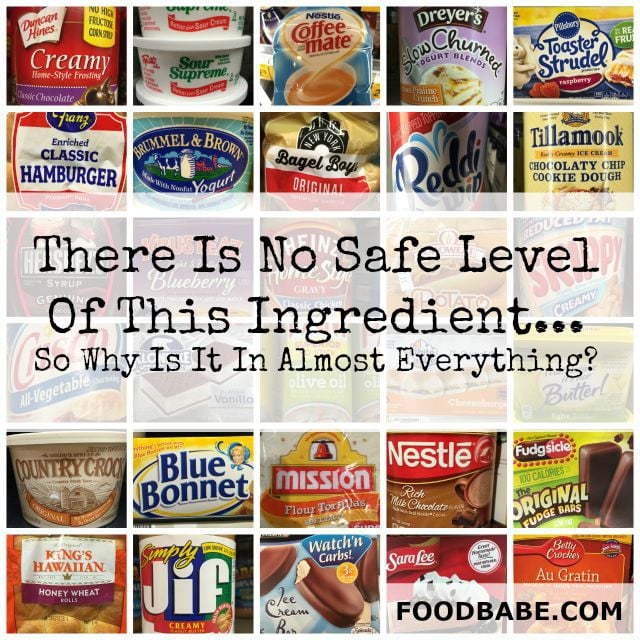
Hidden trans fats can lurk in other processed ingredients.
You may have heard in the news that the FDA finally banned “partially hydrogenated oils” from our food (within the next 3 years). This is a step in the right direction – although a long time coming – because the consumption of artificial trans fat is strongly correlated an increased risk of type 2 diabetes and heart disease, and has been shown to lower good cholesterol and raise bad cholesterol levels for quite some time. The CDC has linked it to an increase in death rate and The Institute of Medicine says that trans fats have “no known health benefit” and there is no safe level to eat. No safe level! This ingredient should never have been allowed in our food in the first place! But, it’s not time for a celebration quite yet…
Although the FDA banned partially hydrogenated oils, they don’t address the other artificial additives in our food that also contain these heart-wrecking artificial trans fats. According to the EWG, some refined oils, emulsifiers, flavors and colors also contain trace amounts of trans fat, but they don’t need to be labeled as such and won’t be removed from our food.
In fact, a very common emulsifier in processed food is one of these hidden sources of trans fat – and I’m sure you’ve heard of it.
If you are as diligent about reading ingredient labels as I am, I guarantee that you’ve seen this ingredient listed on the label, and probably wondered what the heck it was.
Usually labeled as “Mono- and Diglycerides of Fatty Acids”, or “monoglycerides” and “diglycerides” on an ingredient list – this is one of the most widely used emulsifiers that helps keep oil and fat from separating.
This additive is a byproduct of oil processing – including partially hydrogenated canola and soybean oils – which contain this artificial trans fat that is so detrimental to our health. Even though mono- and diglycerides may contain trans fat, they aren’t required to be labeled as trans fats on food packages, and can even be in food labeled “No Trans Fat”. The FDA labeling regulations on trans fat only apply to triglycerides, and not to emulsifiers like mono and diglycerides. According to nutrition researcher Mary Enig, Ph.D., mono- and diglycerides are:
“usually by-products of fats and oils processing such as partial hydrogenation and various forms of extraction and interesterification processes. Even though they do have some caloric value, they are not counted as fats, and the fatty acids are not identified as having a particular composition. If they are fatty acids with trans bonds, they are not likely to be identified as such, nor would they be identified as any particular fatty acid…
… as the public becomes more aware of the dangers of trans fats, the industry may be tempted to add more MGs [monoglycerides] and DGs [diglycerides] containing trans fats in order to obtain the qualities they want in a food without having to list trans fats on the label”.
Sure enough, mono and diglycerides are in a lot of foods that are labeled “No Trans Fat” and “Zero Grams of Trans Fat”, such as Crisco shortening, Franz New York Bagel Boys Bagels, and I Can’t Believe It’s Not Butter Light version. I’m not sure how much trans fat may be in these products based on them containing this ingredient but I definitely would leave them on the shelf.
Food companies are looking for cheap replacements to partially hydrogenated oils – will they be using more “monoglycerides” and “diglycerides”?
To really avoid artificial trans fats, keep in mind that the “No Trans Fat” label just means that the product contains less than 0.5 grams of trans fat per serving from partially hydrogenated oils (while still allowed in food), but they could still contain additional trans fat from hidden sources like mono and diglycerides.
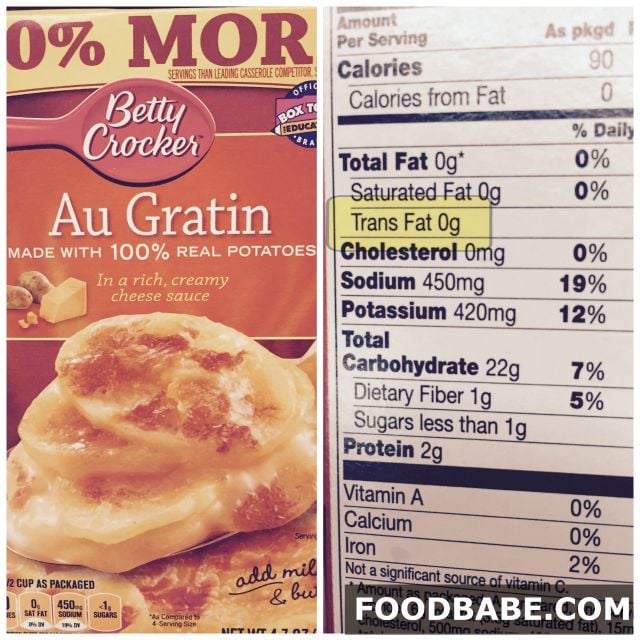
If you eat anything processed (tortillas, bread, ice cream) monoglycerides and diglycerides are nearly impossible to avoid.
I went to a conventional grocery store near my home to take some pictures for this post, and was really shocked at what I found. As I walked down every aisle looking for this ingredient, I literally blew up my phone with dozens of pictures. It’s in freaking everything! Okay, not really “everything”… but I found it in several of these types of products like bread, tortillas, cakes, donuts, nut butters, non-dairy creamer, margarine, and ice cream.
It’s used to increase the shelf-life of baked goods (breads, cakes, dough) and to make them softer without adding butter or oil – which is more expensive. I also found it added to cheap peanut butters and margarines too (especially the brands that previously used partially hydrogenated oils)!
Why Some Ice Cream Sandwiches Don’t Melt
Remember seeing this video last year that showed the Walmart ice cream sandwiches that don’t melt in 80 degree weather? This is why. Additives like mono- and diglycerides can be added (along with other emulsifiers) to make low fat ice cream taste creamier – and also to keep it from melting quickly! I’d rather have ice cream that melts like it is supposed to, instead of chemical-additive filled ice cream that’s been designed to stay frozen longer. I’m sure you would too.
You’ll also have a hard time getting away from this ingredient if you’re still dining at mainstream restaurants.
If you read my book, you may remember this ingredient is added to Olive Garden’s famous breadsticks and the complimentary bread that is left on your table at the Cheesecake Factory. I found that almost every menu item at McDonald’s contains “mono- and diglycerides” because it’s in their buns – even their new “Artisan” buns – shakes, ice-cream, frappes, biscuits, and the liquid margarine that’s used to cook their eggs. You also could be eating this ingredient at Burger King (buns, chicken fries, ice cream, croissants), Wendy’s (Frosty, tortillas, buns), TCBY Frozen Yogurt, and Chick-fil-A (white buns, milkshakes, Frosted Lemonade).
Some forward-looking restaurants (thank you Panera) have committed to removing mono and diglycerides, but most restaurants use it in at least some of their food. Why wouldn’t they? It’s cheap, makes the food last longer, and restaurants aren’t required to tell you what the ingredients are in their food if they don’t want to.
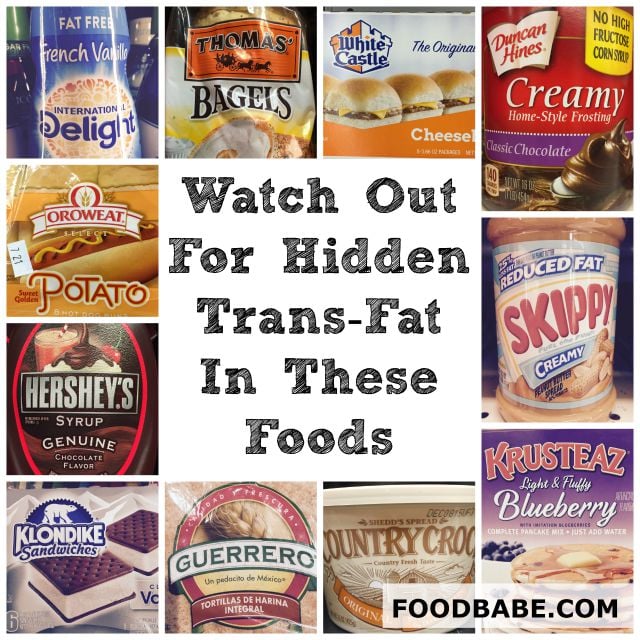
How much of this ingredient are we really consuming?
This additive is usually added in small amounts to food, but it’s added to so much of it – do we really know how much the typical American is eating? Anyone who is still eating out at conventional restaurants, buying packaged bread, tortillas, peanut butter, margarines, and ice cream, could be eating several doses of this ingredient… every. single. day.
I reached out to a food scientist at Penn State to comment on the safety of this ingredient and unfortunately there haven’t been many studies conducted on the level of trans fats that are present. Which begs the question, why are we eating this invented chemical that hasn’t been proven safe anyways?
Please continue to be vigilant about reading ingredient labels and if you don’t understand why an ingredient is there to improve your health, put it back on the shelf and run far far away.
Do you know someone who might be eating mono and diglycerides? Then share this post with them – everyone deserves to know what’s in their food, why it’s in there and the risks of eating it.
Xo,
Vani


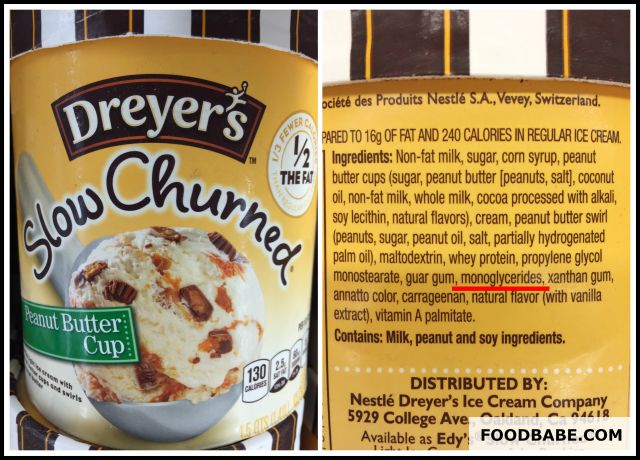

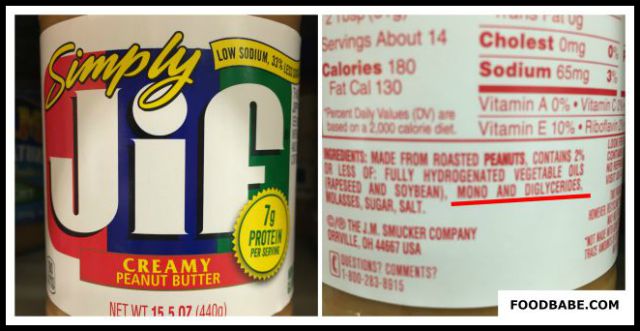

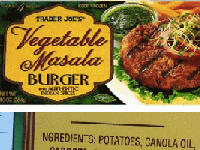




I recently looked at the list of ingredients on a package of Sunflower Seeds my brother was eating, I couldn’t believe it: natural & artificial flavors, partially hydrogenated soybean oil, sucralose etc., in SUNFLOWER SEEDS! Why not just sunflower seeds & salt? Is it really that difficult to keep things simple?!! These greedy, skeevy companies do this to save (and make they hope) more money, none of which translates as savings (or health!) to the buyer. It’s sickening.
On the very few occasions I still buy packaged food items, I carefully read each ingredient before buying. Anything with a questionable ingredient is promptly discarded. I threw out those damn “sunflower seeds” too.
Do you know what any of them actually are? Processing wise?
Hydrogenation is done by a process that does not occur in nature, and twists fatty molecules to produce over 300 novelty molecules. Who knows which ones cause the harm?
Trans fats include conjugated linoleic acid (CLA), which is essential and helps in weight loss, and trans-vaccenic acid, found in dairy products and shown to be beneficial for heart health.
The hype about “trans fats” lets manufacturers use FULLY hydrogenated oils, which have no more trans fats but more of all those other things.
Use fats and oils that God or Mother Nature made, such as real grass-fed butter, unrefined coconut oil, olive oil (careful–most of the olive oil in the US is fraudulent–adulterated with other oils), avocado oil and so on.
I agree! we should only be eating what God made!
Umm… MSG has far more damaging consequences on the body as a neurological disruptor and neurotoxin. At least in the case of Trans fats, the damage can be reversed with a simple series of nutrient dense whole foods, cleanses and detoxs. MSG is hidden in far more foods and has lasting, irreversible consequences leading to diseases and dysfunctions of the nervous system, brain, organs and endocrine system. If any single toxic chemical should be banned – it’s that and aspartame.
Vani did not say that MSG or aspartame are just fine. This is an article about mono and diglycerides. I find articles one just one or two things more helpful than a slew of things because it helps me better able to remember these specific harmful ingredients.
MSG is naturally occurring as well is monoglycerides. That’s why it’s in a lot of your food, it’s naturally occurring, which your body probably needs some amount of it. I’m not saying don’t watch what you eat, but I’d love to see someone function at Olympic athlete level without ingesting some amounts of these nutrients
Wow, this is crazy! If there is .4 grams of mono/diglycerides in 20 items of food that you’re eating per day, then you’d be eating 8 grams of trans fat per day!!! Ahhh! That is so gross. Why doesn’t zero mean zero??? Thank you for doing this research! I am going to tell everyone!
Wow, did u really believe this crap?
How about doing research by yourself? and i mean REAL research
Wow, do you really believe the lies that the government and media want you to believe?
To Mr Obvious: So, do you work for the Grocery Manufacturers Association?
That’s the organization spending millions of dollars to fight legislation that would tell us what’s really in our food: GMOs, additives, and all other ingredients that exist only to benefit food manufacturers (a name that says something – manufacturing, not growing, food) and not actual people!
Oh wait, I forgot, corporations are people. So there you go…
Do you really think anyone doesn’t think you are a Monsanto troll
Real research….as in the studies bought and paid for by Dupont and Monsanto? That kind of “Real” research?
Could you give us a list of all the different “names” for trans fats and ingredients that we should look for on nutrition labels please?
This is a “Tempest in a teapot” Virtually ALL of the foods listed are heavily processed crap tha anyone with any health awareness will reflexively avoid anyway
Is Smart Balance Butter safe?
What about a list that is safe instead of unsafe ?
If you look at the ingredients when you go to the store, if it says monoglycerides or diglycerides, then it’s in it.
The Center for Science in the Public in the Public Interest ( CSPI ) actively promoted trans fat as a healthy alternative to saturated fat! This was in the 1980’s. They have since removed this from their website. What a joke they are !
I don’t eat any of these products but only nutrient dense fresh foods and pasture raised meats and poultry so I don’t have to worry about any of this crap, but thank you for the article since many people are unaware!
You might want to investigate what animal protein actually does to your body and how much disease is linked to consumption of animal products. Forks Over Knives is a great video on the subject. There are also serious concerns regarding pollution, carbon and water footprints as well as animal welfare issues associated with animal agriculture. The entire enterprise is bad for the environment, bad for public health and certainly horrific for the animals who suffer immense abuse and cruelty and ultimate death at an early age and under the most savage of circumstances. I urge you to consider and more compassionate and more earth friendly diet. Peace and blessings. <3 Animal Lives Matter <3
I’ve seen it. And if you know anything about grass fed beef and permaculture you would not make those statements. I have actually reversed many conditions including fibro by consuming grass fed meats. Many vegetarians eat so much processed food by trying to fake their way into believing that they are eating meat.
You should probably read some books about permaculture so you understand it better. I suggest starting with Joel Salatin’s Folks This Ain’t Normal. He also offers many titles of great authors that prove my point.
I eat mostly vegetables as they are so nutrient dense but get very tired of hearing people bash meat eating when what they are really against is CAFOs or confined animal farming organizations.
not really, just because there pasture raised doesn’t mean the animal feed won’t contain trans fat foods.
Ugh! Gross. I can’t believe there are so many hidden trans fats in processed foods. That is why I try to eat as clean as possible with fresh meats, fruits and vegetables. One place I do like to shop is Trader Joes because most of the food they sell do not have so much junk in them.
Beware of trader joe’s too. Always check ingredients no matter where you shop.
https://foodbabe.com/2013/08/07/what-is-trader-joes-hiding/
Wow! Thanks for that link. I had no idea. So glad Foodbabe exposes such things.
Thank you Vani. I had never heard of this ingredient, but now realize it is in a lot of packaged food. Even though I don’t eat this kind of food, it is good to know. Keep fighting the good fight and never mind all the trolls that obviously have nothing better to do with their time than follow you around on the internet making ridiculous comments.
And might I add that I hope by raising awareness of these type of ingredients, that this will encourage food manufacturers to eliminate them from their foods, so that people who do not have a choice but to eat these items (low income, food bank consumers etc.) will not have to consume these harmful ingredients any longer.
Vani,
I’ve noticed a trend by manufacturers of “good” food products (Kashi, etc) to put chicory root (or I think it also goes by inulin) in their products to increase the fiber content. What is your opinion on this? Is there any other problems with this ingredient? I ask mainly because I have some unpleasant side effects from anything with chicory root.
Best Regards,
Jim
Inulin is also in sunchokes and if by “side effects” you mean intestinal gas then yes, it’s known to cause that.
Hi Vani
Ever done an investigation on protein shakes? Vega etc. Magnum etc. ? Is it good bad .. interested
Home alternatives
Thanks!
Vani,
I just want to say how awesome you are and thank you for putting out this info for us. It really has shed some light on a lot of questions I have had and is going to help my health as well as weight loss. You rock!
This is some great information and opened my eyes to safe levels of ingredients.
Thank you! just know your fight is an amazing fight and it will get scary but all the good people who are tired of this horrible ingredients in our food will stand with you ,this is crazy how they think its OK do they eat this!! But great job no matter what they say the real truth will come out and the world should know why there getting sick!
You rock Food Babe! Thank you so much for having the courage to speak up and tell us what’s really in our food! If it weren’t for you I would still be eating Little Debbie! Imagine that!
I do have one question, though. How did companies that were started by nice people that actually CARED turn into evil companies that only care about money and are putting toxins in our food?
Also, I read something at buzzfeed.com that said animal tissue was in marshmallows. You might want to write an article about that. 🙂 Once again thank you so much!
I am slowly becoming aware of the food additives I have been eating my whole life.
10 years ago I became type 2 diabetic.
I joined the Peace Corps and they placed me in Albania.
After 6 months as a volunteer there, my diabetes mysteriously went into remission.
When I came back to the US, my symptoms returned.
The only thing I can attribute this to, was the food I had been eating.
In Albania, most foods are not processed, or treated with chemicals. All food comes from family farms. No GMO’s are allowed in the country.
This is just a silly (and tragic and harmful) game the FDA and the food industry play. The FDA could easily close this loophole. They could say no to trans fat period. If that’s impossible, they could lower the limit from .5 to .005 and count overall trans fat content, regardless of what chemical ingredient it comes in. This is just a damn game for them. How to make it look like your taking action when you’re really not.
Thank you Vani /food babe…
I used to love Skippy peanut butter but these passed months….reading all these things about the food in the supermarkets and restaurants…I quit almost all processed food and I learned to make a lot of things myself along the way….stepping up my gardening
I feel happier day by day for I feel more and more accomplished and provisioned.. esp when I harvest my garden and make deliscious things with it
Thank you and keep up the good work
Thanks for your article. I’ve known to avoid these ingrediants for a long time thanks to a Dr. Speaking on NPR. Honestly though, you should be shopping at better stores. I rarely go anywhere but TJ’s and still check the labels!
I’m an artisan ice cream maker in Scotland, and am very pleased to have read your article today. I do not use these chemical emulsifiers (mono and di-glycerides of fatty acids) but instead use egg yolk, which is a long-standing traditional emulsifier for ice cream. The downside is that other ice creams taste creamier than ours, but they also have a big downside: they leave a slight chemical after-taste. I wish I could get that extra-creamy texture, but I can’t. Not unless I want to compromise my approach and use synthetic chemical emulsifiers.